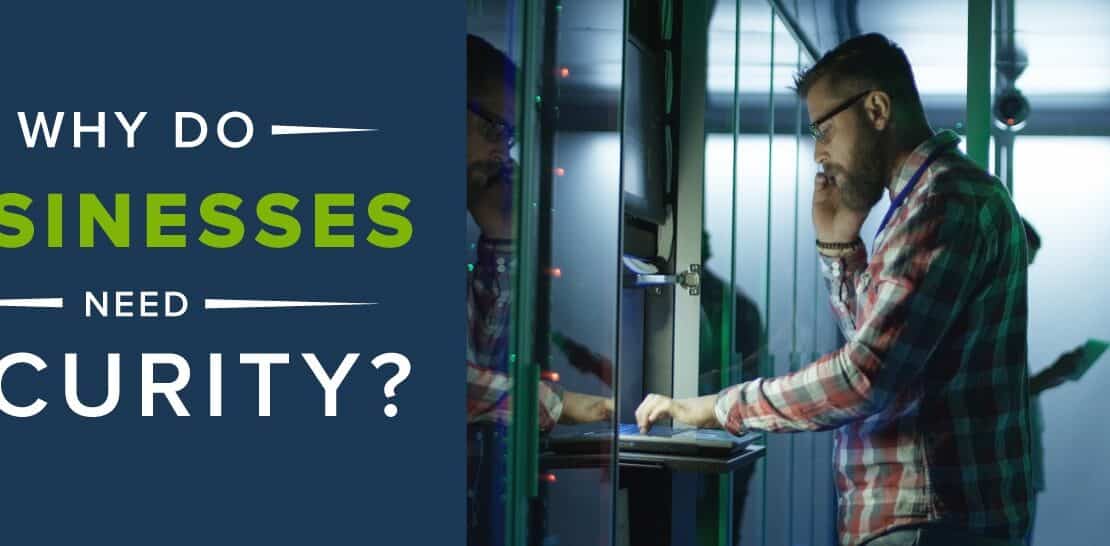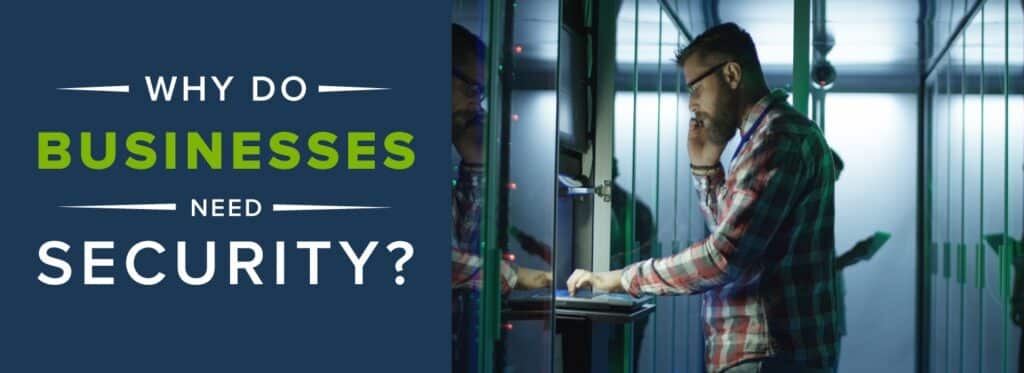- July 3, 2025
- Posted by: Interwest Communications Team
- Categories: Business plans, News

Originally posted on June 25, 2024 @ 10:13 am

Why Do Businesses Need Security: Essential Safeguards for Success
Businesses today face an increasingly complex landscape of security threats, from sophisticated cyberattacks to insider vulnerabilities. The need for comprehensive security measures is more pressing than ever.
Ensuring robust security systems is essential for protecting sensitive information, maintaining customer trust, and complying with legal requirements. In an era where data breaches and cyber threats are on the rise, any lapse in security can result in significant financial and reputational damage.
Small and medium-sized enterprises (SMEs) often struggle to implement effective security measures despite ongoing efforts from regulatory bodies and security experts. This gap in security measures leaves many businesses exposed to potential cyber-attacks, emphasizing the necessity to integrate security protocols into daily business operations.
Notably, some businesses have found that their security concerns do not always align with those of their customers, calling for harmonization and better communication of security priorities.
Moreover, the susceptibility to insider threats where employees have direct access to sensitive company data cannot be overlooked. Organizations must adopt advanced security technologies and foster a culture of security awareness among staff.
Training and awareness programs can serve as preventive measures, reducing the risk of both external and internal threats.
Key Takeaways
- Businesses need robust security to protect data and maintain trust.
- SMEs often lack comprehensive security measures, leading to vulnerabilities.
- Insider threats highlight the importance of employee security training.
Understanding the Threat Landscape

As businesses become more interconnected, the variety of cyber threats has expanded. Companies must stay informed about the different types of cyber threats, the evolution of cybercrime, and current trends in cybersecurity risks to protect their operations and data effectively.
Types of Cyber Threats
There are several types of cyber threats that businesses face today.
- Phishing attacks deceive users into sharing sensitive information by impersonating trustworthy entities.
- Ransomware encrypts a victim’s data, demanding payment for the decryption key.
- Malware includes viruses and spyware that infiltrate systems to steal data or disrupt operations.
- Denial of Service (DoS) attacks overwhelm a system to make it unavailable.
- Social engineering manipulates individuals into divulging confidential information.
We must be vigilant about these threats to safeguard our networks.
The Evolution of Cybercrime
Cybercrime has evolved significantly over the years. Initially, attacks were often amateurish and aimed at causing disruption. Today, cybercriminals are more sophisticated, forming organized groups that operate like businesses.
The rise of the dark web has facilitated the buying and selling of stolen data and hacking tools. As technologies advance, so do the tactics of cybercriminals, making it crucial for us to continually update our security measures and stay ahead of potential threats.
Current Trends in Cybersecurity Risks
Current trends in cybersecurity risks highlight the growing complexity of threats.
Advanced Persistent Threats (APTs) involve prolonged, targeted attacks designed to steal data or monitor systems.
The increasing use of cloud services introduces new vulnerabilities.
Artificial intelligence (AI) and machine learning (ML) are now used by both attackers and defenders, creating an ongoing arms race.
Supply chain attacks target less secure elements to compromise larger networks.
By staying informed about these trends, we can better prepare and defend against potential hazards.
The Importance of Cybersecurity for Organizations

Cybersecurity is crucial for safeguarding sensitive data, preventing costly data breaches, and ensuring compliance with various regulatory requirements. It serves as a foundation for protecting organizational operations and maintaining trust with stakeholders.
Protecting Sensitive Data
Organizations handle vast amounts of sensitive data, including personal information, intellectual property, and financial records. Ensuring this data is protected from unauthorized access is critical. Cybersecurity measures such as encryption, multi-factor authentication, and secure access controls help safeguard this information.
Sensitive data protection is not limited to external threats. Insider threats, whether malicious or accidental, also pose significant risks. Clear security policies and regular employee training can mitigate internal risks by making staff aware of best practices and potential threats.
Preventing Data Breaches
Data breaches can result in severe financial and reputational damage. Implementing robust cybersecurity measures can prevent these breaches. Firewalls, intrusion detection systems, and regular security audits are essential tools.
Organizations should also maintain up-to-date software and patches to address vulnerabilities that could be exploited by malicious actors. Monitoring systems for unusual activity and conducting penetration tests to identify potential weaknesses further enhance security efforts.
Compliance and Regulatory Requirements
Compliance with regulatory requirements like GDPR is mandatory for organizations handling sensitive data. Non-compliance can result in hefty fines and legal repercussions. Cybersecurity ensures that organizations meet these standards and protect themselves legally.
Organizations must implement appropriate measures to comply with industry-specific regulations. Regularly reviewing and updating security policies to align with changing regulatory requirements is essential for maintaining compliance and protecting sensitive data. Integrating these practices not only safeguards data but also enhances organizational reputation and trust.
Developing a Robust Security Strategy
Businesses need well-developed security strategies to protect their assets, respond effectively to incidents, and continually improve their defenses.
The following subsections delve into key components crucial to a robust security strategy.
Risk Assessment and Management
Risk assessment and management are vital for identifying potential threats and vulnerabilities within a business. By conducting a thorough analysis, we can determine the likelihood and potential impact of various risks, both physical and cyber.
Steps in Risk Management:
1. Identify Assets: Determine what needs protection.
2. Identify Threats: Recognize possible security threats.
3. Evaluate Vulnerabilities: Assess points of weakness.
4. Assess Impact: Understand what the fallout could be.
Using this information, we can prioritize risks and allocate resources more effectively. For example, investing in firewalls and multifactor authentication can mitigate the greater risks identified. Documenting and updating this process ensures it stays relevant.
Incident Response Planning
An incident response plan (IRP) enables us to act quickly and effectively during a security breach. A well-structured IRP outlines the steps to take, roles and responsibilities, and communication strategies to minimize damage and recover swiftly.
Key Elements of an IRP:
- Preparation: Establish policies and educate employees.
- Identification: Detect and determine the nature of the incident.
- Containment: Limit the impact by isolating affected systems.
- Eradication: Remove the cause of the incident.
- Recovery: Restore systems and data to normal operations.
Regularly testing this plan through drills ensures everyone knows their role, which reduces chaos and accelerates recovery during an actual incident.
Continuous Monitoring and Improvement
Security threats are constantly evolving, making continuous monitoring and improvement essential for maintaining robust defenses. This ongoing process involves real-time monitoring of networks, regular audits, and updates to protocols.
Components of Continuous Monitoring:
- Real-time Analysis: Use tools to monitor network traffic and detect anomalies.
- Regular Audits: Conduct security audits to discover new vulnerabilities.
- Protocol Updates: Update security measures based on the latest threat intelligence.
By integrating these practices into our daily operations, we can swiftly identify and address new threats, adapting our security measures to stay ahead of potential attackers.
Adopting Advanced Security Technologies
Businesses must prioritize advanced security technologies to safeguard their data and IT infrastructure. This requires implementing robust security measures such as firewalls and encryption, and securing both networks and IT systems to protect against threats.
Implementation of Firewalls and Encryption
Adopting firewalls is essential for controlling incoming and outgoing network traffic based on predetermined security rules. Firewalls act as barriers between trusted and untrusted networks, helping prevent unauthorized access. We must configure and maintain these firewalls effectively to ensure robust protection.
Encryption complements firewalls by converting sensitive data into unreadable code, which can only be deciphered by authorized entities with the correct decryption key. This process protects data during transmission and storage, making it difficult for cybercriminals to access and misuse. Utilizing advanced encryption algorithms not only complies with regulatory standards but also instills trust among clients and partners. Integrating encryption within our systems is a proactive step toward comprehensive security.
Securing Networks and IT Systems
Protecting our networks involves deploying multiple defense mechanisms. These include intrusion detection systems (IDS) and intrusion prevention systems (IPS), which monitor and analyze network traffic for suspicious activity.
Regular updates and patches to software and hardware are critical to close vulnerabilities.
AI-driven technology enhances our ability to detect and respond to threats in real-time. AI algorithms can identify patterns associated with cyber-attacks, enabling us to act swiftly against potential breaches.
Securing IT systems also necessitates strict access controls and user authentication protocols to ensure only authorized personnel can reach sensitive data and critical systems. Routine security assessments and audits help us identify weaknesses and reinforce our defenses.
By investing in advanced security technologies, we can mitigate risks, ensure compliance, and maintain operational integrity.
Training and Awareness as Preventive Measures
Effective training and awareness programs are critical to a company’s cybersecurity defense. These initiatives equip employees with the knowledge to identify threats and foster a culture focused on security.
Below, we delve into essential elements such as cybersecurity training for employees, fostering a security-conscious culture, and understanding social engineering tactics in greater depth.
Cybersecurity Training for Employees
Our company prioritizes robust cybersecurity training programs designed to equip employees with essential skills. These programs cover the basics of identifying phishing attempts, recognizing suspicious activities, and handling sensitive information securely.
Interactive modules, such as simulations and real-world scenarios, reinforce learning and make the training engaging.
Regular updates to training material ensure that employees stay informed about the latest threats and safety measures. Providing refresher courses on a quarterly basis helps keep cybersecurity practices top-of-mind.
By emphasizing the importance of continuous learning, we ensure that our workforce evolves alongside emerging threats.
Promoting a Security-Conscious Culture
Fostering a security-conscious culture involves more than just training; it requires a shift in mindset across the entire organization. We emphasize the importance of cybersecurity through regular communications, highlight best practices, and encourage employees to report suspicious activities without fear of repercussions. Creating an environment where security is everyone’s responsibility is key.
Leadership plays a crucial role by modeling good cybersecurity behavior and supporting training initiatives. Regularly scheduled meetings and discussions facilitate an ongoing dialogue about security issues, helping to keep the topic relevant and front-of-mind.
Recognition programs for employees who demonstrate outstanding cybersecurity practices can further reinforce a security-focused culture.
Understanding Social Engineering Tactics
Social engineering exploits human factors rather than technical vulnerabilities. Our training programs include detailed scenarios illustrating common social engineering tactics, such as phishing, pretexting, and baiting. By demonstrating how attackers manipulate trust and exploit psychological triggers, we help employees recognize and avoid these threats.
Practical exercises, like simulated phishing attacks, are effective in teaching employees how to respond to real-world threats. Regular debriefings after these exercises discuss what was done well and what could be improved, providing valuable insights for both employees and the organization. Educating employees on these tactics builds a critical line of defense against increasingly sophisticated social engineering attacks.
The Economic Perspective of Cybersecurity
Businesses face numerous financial implications due to cyber incidents, making investments in cybersecurity essential. Downtime from attacks can be particularly costly, affecting both immediate revenue and long-term reputation.
Costs Associated with Cyber Incidents
Cyber incidents can lead to significant financial losses through various channels. Data breaches may result in loss of sensitive information, requiring immediate response efforts and increasing costs for businesses. We must also consider the impact on reputational damage, which can reduce customer trust and, subsequently, revenue.
Legal and regulatory fines can be another steep expense. Non-compliance with data protection regulations, such as GDPR, often results in hefty penalties. Additionally, costs associated with incident response and forensic analysis are considerable, diverting resources away from core business operations.
Investment in Cybersecurity Measures
Proactive investment in cybersecurity can help mitigate the financial impact of potential cyber threats. Allocating funds towards advanced security infrastructure, such as firewalls, intrusion detection systems, and encryption tools, is crucial. Investing in employee training also plays a vital role in preventing incidents, as human error remains a significant vulnerability.
Insurance policies tailored for cybersecurity incidents can also reduce the economic burden. These policies typically cover various expenses, including legal fees and recovery costs. By investing in robust cybersecurity measures, businesses can protect their profit margins and ensure resource optimization.
Financial Impact of Downtime
Downtime resulting from cyber attacks can have severe economic consequences. Operational interruptions lead to immediate loss of revenue as businesses are unable to serve customers or complete transactions.
Extended downtime can exacerbate reputational harm, further diminishing customer confidence and loyalty. The recovery process during and after downtime is resource-intensive. It involves not only financial investments but also a significant amount of time and labor. Thus, ensuring business continuity through effective cybersecurity strategies is imperative in safeguarding against the financial ramifications of operational downtime.
Cybersecurity Considerations for Specific Sectors
Different sectors have unique cybersecurity needs and challenges. We focus on how small businesses, critical infrastructure, and emerging technologies can address these concerns effectively.
Small Businesses and Cybersecurity
Small businesses often lack the resources of larger enterprises but face many of the same threats. Investing in cybersecurity measures such as firewalls, intrusion detection systems, and regular employee training can provide significant protection.
The use of cloud services can enhance security by leveraging advanced technologies and expertise available through these platforms. Regularly updating software and systems can prevent vulnerabilities. Mobile devices add another layer of risk, so implementing device management policies is crucial.
Protecting Critical Infrastructure
Critical infrastructure includes sectors like energy, telecommunications, and water supply, where disruptions can have widespread impacts. These sectors must focus on both physical and cyber threats.
Robust network segmentation and real-time monitoring systems are essential.
Implementing stringent access controls can limit unauthorized access.
The use of IoT devices in critical infrastructure provides enhanced operational capabilities but also introduces security challenges. Ensuring that these devices are secure and regularly updated is vital.
Security Challenges in Emerging Technologies
Emerging technologies like IoT and cloud computing present new security challenges.
IoT devices, due to their interconnected nature, can serve as entry points for cyber-attacks. Ensuring these devices have secure firmware and strong encryption practices is essential.
Cloud services, while offering scalable solutions, require secure access protocols and regular vulnerability assessments.
Mobile devices, increasingly used for business operations, must be protected through strong authentication methods and encrypted communications.
These measures can help mitigate risks associated with the adoption of new technologies.
Emerging technologies require a comprehensive approach to cybersecurity to adapt to evolving threats effectively.
